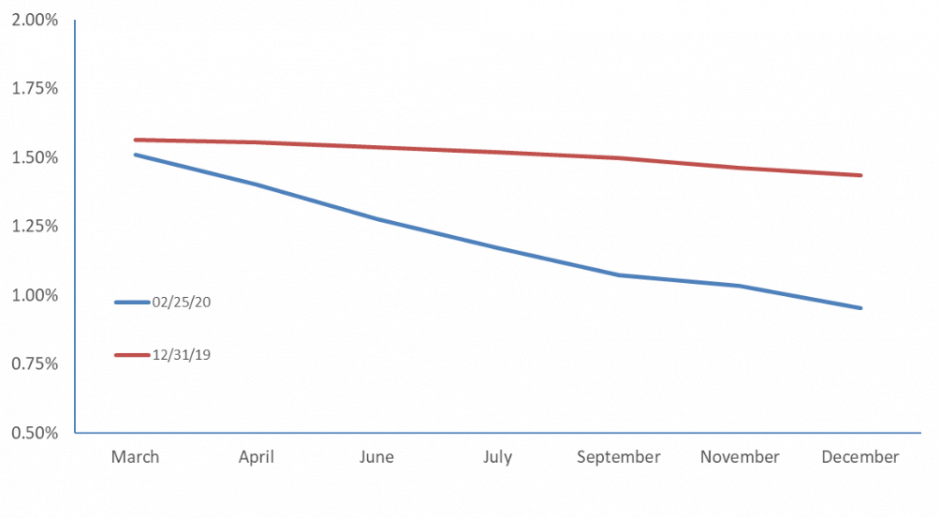
Janus Henderson Investors: Coronavirus uncertainty likely to force Fed’s hand

Co-Head of Global Bonds Nick Maroutsos explains why markets reacted as they did in the face of the spreading coronavirus and why the US Federal Reserve (Fed) will ultimately have to cut rates to account for the outbreak’s economic impact.
27.02.2020 | 13:50 Uhr
Key Takeaways
- This week’s (24 February 2020) market sell-off was largely driven by investors pricing in supply chain disruptions, lower profits and slower economic growth as the consequence of the spreading coronavirus.
- As with other recent sell-offs in riskier assets, we believe the US Federal Reserve will cut interest rates to support financial markets.
- Once the virus is ultimately contained, the combination of greater
policy accommodation and low inflation should be conducive for economic
growth and riskier assets. However, we expect additional volatility in
the interim.
After weeks of deflecting concerns about the outbreak of the COVID-19 coronavirus, financial markets have reacted fiercely over the past two trading sessions, causing a sell-off in equities and pushing the yield on ‘safe-haven’ 10-year Treasuries to record lows. We view this week’s market moves as a rational – albeit dramatic – reaction to the public health and economic uncertainty surrounding the virus.
With outbreaks in South Korea, the Middle East and Italy’s industrial heartland, the virus has spread more rapidly than many had anticipated just a few weeks ago. Our foremost concern is for the victims, and we hope that coordinated global action, along with an impending warmer spring, will keep the outbreak in check.
We have reached a point, however, that a real economic impact can start to be identified. Supply chains are being disrupted, companies have begun issuing profit warnings and economists are downgrading growth in certain regions, especially those linked to China’s manufacturing base. Consequently, while some of this week’s market moves are likely driven by fear, also contributing, in our view, are investors factoring in the real impact that the virus is having on corporate and economic fundamentals.
More accommodation on the way
While the headline grabber has been the equities sell-off, what catches our attention most is the fierce downward move in US Treasury yields. Much of this is owed to investors’ ‘flight to safety’ in the face of market uncertainty. But we also believe that another contributing factor is the growing expectation that the outbreak – and its potential economic ramifications – will force the Fed to cut rates in 2020. In December, the futures market was pricing in less than one rate cut for this year. That expectation has now jumped to at least two. While we don’t think a March cut is on the table, we believe both the April and June meetings are in play for the Fed to take action.
Fed funds futures implied rate trajectory
Futures markets are now pricing in at least two Fed rate cuts in 2020, compared to a forecast of less than one in December.

Source: Bloomberg, as at 26 February 2020. Data represent expectations of Federal Funds Rate at the time of future Fed meetings.
Should the Fed move as we expect, it will reinforce the policy framework that has been in place since the Global Financial Crisis (GFC), namely the Fed ‘put’ still being in play. While not part of the central bank’s dual mandate, the Fed under the past three chairpersons has persistently shown a willingness to support financial markets. We doubt that the Fed is comfortable with this reality, yet they have enabled it by rewarding nearly every market tantrum with greater accommodation.
Diminishing returns
With China as its epicentre, the coronavirus represents both a supply and demand shock for Asia. In much of the rest of the world, the slowdown in trade is largely a supply phenomenon.
Unfortunately, monetary policy like rate cuts is geared toward spurring demand and is less effective in addressing supply issues. Furthermore, every iteration of accommodation since the GFC has largely delivered diminishing returns. With interest rates already low, and the chief concern being one of supply, we question the efficacy of greater accommodation in spurring economic growth.
In this respect, and with other developed market central banks having even less dry powder than the Fed, we believe that these diminished returns have created a cycle of continued accommodation that is largely unable to catalyse above-trend economic growth.
Managing uncertainty
The economic consequences of the coronavirus will take months to fully calculate. Throughout this period of uncertainty, we expect market volatility to remain elevated. From an investment perspective, we prefer to seek safety in higher-quality assets, including US, German and Australian government debt rather than that of peripheral developed markets.
Eventually, this crisis will pass. Given the still uncertain picture, we believe the recovery will, at first, be somewhat subdued. Ultimately, supply chains will fill again and pent-up demand will be unleashed. Outside the areas most acutely affected by the coronavirus, the global economy appears in good shape.
The economic environment we anticipate for 2020 should be conducive for riskier assets. While we don’t expect returns similar to those registered in 2019, the combination of greater accommodation and still minimal inflation should be favourable for corporate credits and equities. While the former category may be richly valued, there are attractive income streams available. Treasuries yields, in our view, can compress even further on the back of potential rate cuts.



Diesen Beitrag teilen: